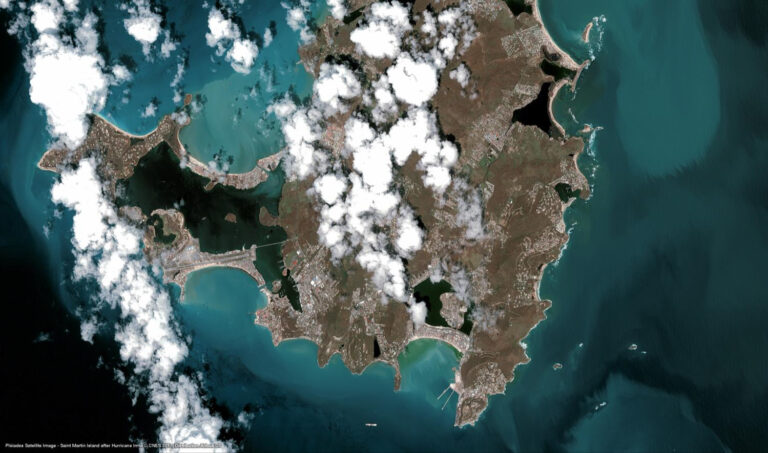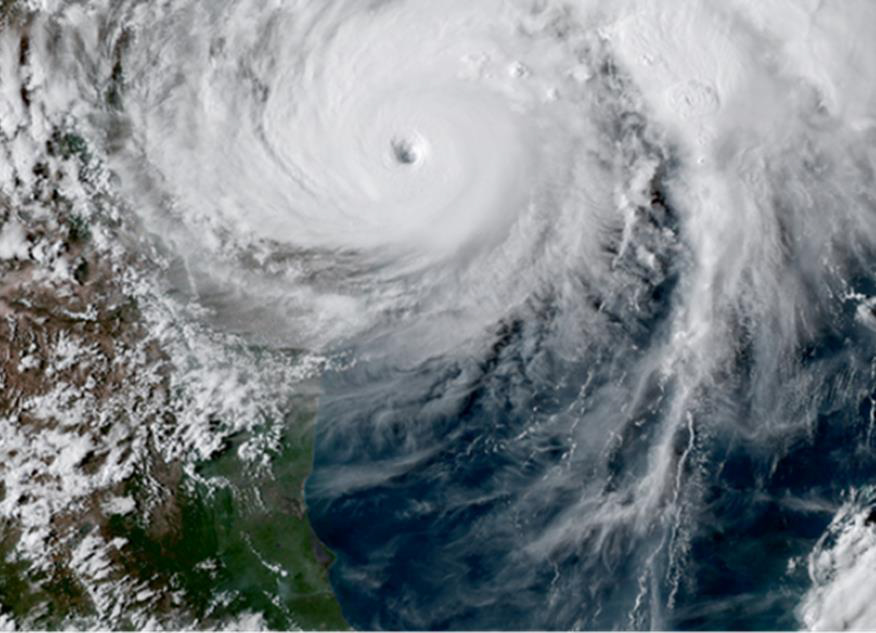THE EVENT...
Hurricanes typically make landfall with a reasonable amount of warning, and it was clear early on that Harvey would be dramatic. Indeed, the storm was catastrophic, dropping 27 trillion gallons of water onto Texas and Louisiana within six days, the most ever for a land-falling tropical cyclone in the US. Combined with the flooding that followed, Harvey displaced an estimated 1 million people, forced over 40,000 to seek emergency shelter and caused an estimated $75 billion in damage.

DISASTER CLAIMS: A VITAL MOMENT
With natural disasters of this magnitude, insurers are inundated with claims as affected policyholders seek to mitigate losses and start rebuilding their lives. This is a vital moment: compassionate and prompt processing is crucial to each customer’s experience, and may even impact the overall reputation of the insurer.
“In other words, speed, accuracy & Customer service are paramount” said Dave Fox, CEO, Geospatial Insight
At the same time, there are key business risks involved in the claims process, especially with
the magnitude of claims that follow a natural disaster. Certain functions, namely damage prediction and individual claims assessment, are resource-intensive, undesirably subjective (particularly if conducted well after the event) and even risky from a public relations standpoint.
Objectivity, accuracy and clarity with respect to client communications can help. Geospatial Insight provides a geospatial approach to managing these multiple critical objectives.
We Offer:
- Assessment of storm path and potential risks, like flooding, to plan and implement an appropriate operational response,
- Macro-level loss estimates of potential damage and likely average claims size,
- Rapid mapping of post event damage at both the regional and property level and
- Confirmation that an individual claim is directly related to the event.
Our service helps insurers anticipate possible losses, ensure sufficient resources and liquidity to respond, make prompt and caring service available to affected customers and rapidly verify the credibility of specific claims. The result is improved accuracy, better service and greater operational efficiency
PRIORITIES FOR HARVEY
As Hurricane Harvey approached Texas, our client, a leading worldwide insurance broker, had three urgent priorities:
- To use Geospatial Insight’s analytics to predict damage and preserve the safety of company staff located in Houston.
- To offer rapid assessments of potential and actual damage throughout the event to individual policyholders.
- To immediately facilitate claims and provide financial relief rather than waiting on service from human assessors.
Our ability to anticipate and adapt to unique storm features is part of what makes Geospatial Insight such a powerful partner to insurers during a CAT event – both for specific properties and full regions.
From geocoding policyholder data to develop baseline assessment and flight plans to ensure logistical resilience throughout a storm’s challenges, we deliver flexible and methodical support, analysis and insight.
Our client also requested access to our proprietary software portal for a small group of customers to foster greater communication and insight throughout the event. Our key output was visual assessment of all related properties, which included both residential and commercial locations for clients ranging from major organisations to individuals.
OUR CLIENT PORTAL: A UNIQUE TOOL FOR ASSESSMENT & CONNECTION
Our unique customer-facing portal offers individual policyholders unprecedented access to information about their properties, including precise flight paths, actual drone footage and damage assessment reports within hours of collection and throughout the weather event itself.
This portal mirrors the service we offer to claims departments, which rely on our swift responsiveness to unfolding CAT events to capture visual evidence and provide immediate assessments of damage. Our services avoid the pitfalls of human assessment, including delays due to logistics and subjectivity of the ex-post damage assessment process. Instead, we offer realtime insight, experienced management of operations in severe conditions and certainty as to what exactly has happened to affected properties.
It isn’t just high technology: it’s a business solution for insurers seeking to streamline and strengthen the claims management process.

Within a week of Harvey making landfall, Geospatial Insight delivered:
- Predictive assessments of storm and flood paths and potential damage to the region and individual property.
- Detailed property-level assessments of damage in real-time.
- A comprehensive customer-facing user interface allowing a group of policyholders to access information and damage estimates.
By embracing our technology and taking the additional step of providing information to policyholders, our client could meaningfully prepare for the financial ramifications of Harvey and initiate prompt, caring and knowledgeable service – well before any human assessor could even begin the work of acknowledging, verifying and resolving claims.
RAPID GATHERING & ANALYSIS
Geospatial Insight uses a multi-pronged approach to data-gathering. We employ the data collection methods that make the most sense for a given event at a given time based on the situation we are analysing and our assessment of key requirements.
As events unfold, we continue to add new sources of information and insight. However,our immediate priority is to begin collection and analysis immediately or even prior to an event occurring, where possible. Crucially, our analytical models have the flexibility to adapt to the situation on the ground without losing predictive power – even if a ‘preferred’ data source is not immediately available.
This flexibility is a crucial part of our service to insurers: after all, our ability to respond would be meaningless without reliability in the predictions and assessments that our technology provides.
In the case of Harvey, our first step was to provide an accurate assessment of the potentially affected area using satellite imagery, storm surge statistics and terrain data.
As the storm moved towards land, the densely populated Houston area was identified as the likely focus of Harvey’s damage. We conducted a rapid review of the locations where damage was most likely to occur and estimates as to what policyholders were likely to need in terms of relief.
Upon making landfall, Harvey made history with torrential rain.
Rainfall reached 50 inches in some places and unleashed 27 trillion gallons of water on Houston and Southeast Texas.
Damage was exacerbated in Houston after the US Army Corps of Engineers were forced to release water into two city bayous, causing significant flooding in neighbouring residential areas.
- To get the most comprehensive understanding of potential damage and claims during the storm, we collected and analysed data from several sources:
- Highly accurate laser-derived terrain data.
- High resolution aerial photography, providing a 360 view of each property.
- Radar and satellite imagery to estimate flood areas.
- Traditional and social media scraping to fill local information gaps and to confirm and refine estimates.

These data-collection efforts were conducted at strategic points during the storm cycle because cloud cover and the need to reserve local airspace for aid and emergency services. We ensured rapid mobilisation and timely intelligence as to the nature and extent of damage caused by the storm.
Every hurricane has the potential to surprise in terms of storm path, rainfall, wind and damage, and Harvey was no exception. While winds remained relatively low for a hurricane of this size, rain was a significant factor in our logistical operation and we adapted immediately to the likelihood that our client’s policyholders would be impacted by severe flooding.
Our ability to anticipate and adapt to unique storm features is part of what makes Geospatial Insight such a powerful partner to insurers seeking immediate and accurate insights about the effects of a CAT event – both regionally and to specific properties.
For example, Geospatial Insight’s Mission Control team saw early on that lingering cloud cover could delay the usefulness of scheduled satellite imaging. As such, we put a specialised aircraft on standby to collect detailed images of buildings from multiple angles at the first opportunity. Within hours of the sky clearing, a Geospatial Insight partner was in the air, and within two days we had collected over 1,000 km of image data focused on imaging specific policyholder properties to determine the existence and extent of storm damage.
In the interim, we leveraged social media analytics and radar imaging to develop assessments of flood areas and the extent of damage in both the greater Houston area and specific client properties. We also conducted flyovers by drone, particularly for locations of additional concern.
This complex image data were analysed by our proprietary algorithms to produce understandable and actionable estimates, reports and damage assessments for both the insurer and individual policyholders.
Our efforts paid off. Within a week of Harvey’s landfall, critical information for individual policyholders was compiled and shared, and our overall data-gathering and analysis operations were nearing completion. Our technology, extensive partner network and inhouse operational expertise are critical to our advantage in delivering this rapid service.
In fact, our client is expanding the use of our Visual Intelligence service to improve client experience and strengthen its ability to respond to claims, and in particular the wave of claims activity that follows a CAT event.
THE ONSET OF IRMA
Just as the rains of Hurricane Harvey were coming to an end, another natural disaster loomed. Hurricane Irma, already causing extensive damage in Cuba and the Caribbean, was approaching the United States with the most powerful sustained wind speed recorded in an Atlantic hurricane since 2005.
The storm was on course to make disastrous landfall in Miami. We monitored its path for 12 chilling hours before Irma suddenly turned and closed in on the Florida Keys, where high winds caused power outages for millions of Floridians. By the time Irma finally subsided, initial estimates found that 25% of homes in the Keys were destroyed while 65% sustained major damage* . Much of the losses were a result of high winds and storm surge flooding.
*Source – Washington Post

“We provided our client’s policyholders with a whole new customer experience” Dave Fox, CEO, Geospatial Insight
OUR CLIENTS' NEEDS...
Given the positive feedback from policyholders during Harvey, our client was eager to expand policyholder portal access to a larger group of customers in Miami and neighbouring areas. We worked to identify and provide information for a shifting group of policyholders likely to be affected by Irma.
This was a significant value-added service for our client. Despite their size, hurricanes are notoriously unpredictable, and the location of Irma’s eventual landfall would have a significant impact on the size and scope of resulting claims. The ability to access real-time insights into areas of possible destruction and specific policyholders and properties helped support our client’s customer service and financial estimation operations.
DELIVERING RAPID INFORMATION RESPONSES TO POLICYHOLDERS
As the storm progressed, we shifted from predictions to assessments. Our team sourced and initiated collection of image data using satellite, aerial-photography and social media. This information was analysed to provide actionable assessments of flooding, flood damage and likely claims estimates.
The expansion of our customer portal provided real-time assessments and image data to over 40 corporate customers. Like our own insurance-facing dashboard, the customer portal for policyholders was designed with usability in mind, so that business owners and executives could quickly identify potential claim location points and make sense of the visual intelligence that we provided.
This service was a critical source of support in a trying time as these businesses adapted their own operations to the realities of each storm. Initial feedback indicated usefulness far beyond expediting the insurance claims process: policyholders used our analytics to adapt operational plans as the storm path evolved, provide much needed support to employees and develop contingency plans for various storm scenarios.
GEOSPATIAL INSIGHT FOR INSURANCE
Visual intelligence is an innovative way for insurers to facilitate claims management, but it can also be used to deepen and strengthen client relationships.
GEOSPATIAL INSIGHT’S VISUAL INTELLIGENCE SERVICE OFFERS THE ABILITY TO:
- Predict the potential damage of a natural disaster.
- Help identify which policyholders are likely to be affected and to what extent.
- Readily develop estimates of potential claims sizes and facilitate total loss estimates.
- Rapidly and accurately assess actual damage down to the property level.
- Objectively and accurately verify claims.
Customer service and risk management are necessary components of the claims process, and Geospatial Insight provides insurers with the opportunity to excel in both areas. Our fast, accurate and flexible analytics offer unprecedented access to information for insurers and policyholders – turning this traditional part of the insurance business into a source of innovation in efficiency and client service.

